Why Fat?
The fact that fat is a better fuel for endurance athletes is not questioned. Burning more fat and less carbohydrates at any given intensity is one of the primary adaptations to training that allow trained individuals to outperform their untrained counterparts.
Here are the reasons why fat is a better than carbohydrates as a fuel source for an endurance event.
1. Higher Efficiency
Fat provides 9 units of energy (Calories) per gram. Carbohydrates provide 4 units of energy (Calories) per gram. If we use vehicle analogy, then we can really see the implications of this fact.
Imagine you are about to take a long drive across the country. You happen to be carrying illegal contraband–raw goat’s milk. (I’m serious, it’s illegal to transport raw dairy products across state lines.)
Therefore it’s important to minimize your fuel stops and complete your drive as quickly as possible. This will give you less likelihood of being noticed or stopped by the police.
Your car, unlike most cars, has 2 main fuel options.
Fuel A provides 90 miles per gallon.
Fuel B gives your car 40 miles per gallon. Which do you choose?
If you chose Fuel A, then you chose FAT.
2. Cleaner Burning
Both fats and carbohydrates require oxygen to burn and provide energy for your body.
Fat produces less waste product (carbon dioxide) for each unit of oxygen used, and also uses less oxygen per unit of energy (Calories) that it gives you.
Burning fat produces 70% as much carbon dioxide per unit of oxygen consumed when compared to burning carbs.
This is why exercise physiologists can determine how much fat and carbs you are burning by measuring the amount of carbon dioxide and oxygen in the air you breathe. This measure is called RQ, or respiratory quotient .
Taking our automobile analogy a step further, imagine for your cross country trip that you have 2 fuel options.
Fuel A produces only 70% of the main waste product that Fuel B generates.
Also, imagine that elimination of this carbon dioxide is a major stressor on your car’s exhaust system, and it can sometimes putter to a stop or slow down considerably when this waste product reaches a high level.
This corresponds to getting “out of breath”, which is as much a product of excess carbon dioxide as inadequate oxygen. Which fuel do you choose?
Would you choose Fuel A or Fuel B? If you chose Fuel A, then you chose FAT.
3. Virtually Unlimited
Fat can be stored in high amounts in your body and has lots of energy per pound. Even a very lean person will have at least 10 pounds of body fat. This amount of fat can provide 35,000 Calories to fuel exercise.
Your body can store carbohydrates for later use in the muscles and liver. However the capacity for storage is very limited. A highly trained athlete can store maybe 500 grams (1.1 pounds) of carbohydrates in the form of glycogen. That’s about 2,000 Calories.
So with our car analogy, imagine that your tank can hold 35 gallons of Fuel A and only 2 gallons of Fuel B. Which would you choose for your long car ride across the country?
If you chose Fuel A, you chose FAT.
So in this analogy your body is a car. Fuel A (fat) gives you more than twice the miles per gallon, 30% less of the waste byproducts that stress your exhaust system, and more than 15 times the fuel tank capacity as Fuel B (carbs).
Maybe a better question is this: Why Carbs?
Why Carbs?
There is one advantage to carbohydrates. They provide the fuel for higher power output. They burn faster and can provide fuel in situations where fat burning may be too slow, such as faster running or steep inclines.
With our cross-country goat’s milk smuggling analogy, imagine Fuel A can take you as high as 80 mph but no faster. Fuel B can take you about 180 mph, but you can only burn 2 gallons before refueling.
If your goat’s milk smuggling operation is discovered by the authorities and you have to outrun the police, which fuel do you want to burn?
Fuel B, that’s right, CARBS.
It seems the best approach would be to rely on fat as much as possible and keep some carbs in the tank for any uphill climbs, or for a strong surge at the end of the race.
How To Burn Fat While Running
“The most potent way to enhance your body’s burning of fat, whether you’re sedentary or a world class athlete, is restricting carbs. It’s more potent than any other lifestyle modification, more potent than any drug.” –Dr. Jeff Volek
Many endurance athletes are experimenting with low carbohydrate, high fat diets in an attempt to get their bodies to rely more on fat during exercise. Traditionally, sports nutritionists have recommended a high carbohydrate diet for athletes.
There is plenty of evidence that the high carbohydrate diet works. In short term studies where high and low carbohydrate diets have been compared, athletes on the high carbohydrate diet perform better.
Presumably this is due to higher amounts of glycogen–your body’s storage form of carbohydrate. High carb diets help keep your glycogen stores higher. This give you more fuel for fast, immediate use.
However some athletes such as Zach Bitter and Timothy Olson have been experimenting with long term carbohydrate reduction. In theory, this will shift your body’s metabolic engines to burn more fat during exercise.
If this “fat adapted” diet works, then you will be able to go faster and farther in a race with less refueling and therefore a lower chance of digestive issues or glycogen depletion (bonking).
In order to turn your body into a fat burning machine with enough carbohydrate on board for a strong kick at the end of a race, you could train low and compete high when it comes to carbohydrates.
Does Any Research Support Fat Adapted Running?
As of now, there is not much published research to support this approach. One study published in the American College of Sports Medicine’s journal in 2010 found that training in a low glycogen state enhances fat burning. (1)
But it is important not to mistake absence of evidence for evidence of absence. In other words, long term low carbohydrate, high fat diets have not been studied much in athletes.
However, there is enough evidence to make high fat, low carb eating a serious consideration for any endurance athlete.
Dr. Jeff Volek is currently conducting research designed to look at the metabolic differences between high level endurance athletes following a low carbohydrate, high fat diet and those following a high carb diet.
This study is called the FASTER study. (Fat-Adapted-Substrate oxidation in-Trained-Elite-Runners)
So far the results look promising for this approach. Dr. Volek plans to publish the results soon. (Later in 2015.)
This study looked at 2 groups of endurance athletes, one group on a long term low carbohydrate diet (LCD), the other group was on a long term high carbohydrate diet.
Other than diet, the athletes in the 2 groups were very similar:
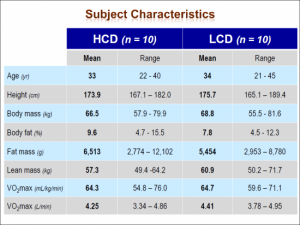
The low carb group (LCD) had an average of about 10 percent of their calories from carbohydrates and about 70 percent from fat. The high carb group (HCD) had approximately 60 percent of their calories from carbohydrates.
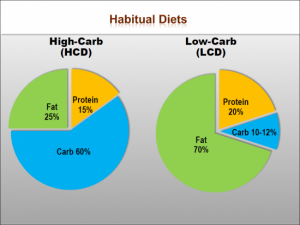
Each participant was tested for VO2 Max. Fat and carbohydrate utilization were measured during this testing. Notice the low carb group used more fat during exercise at every intensity level:
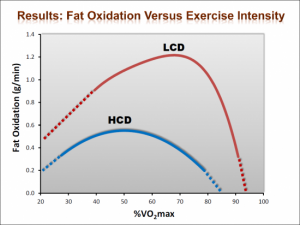
The low carb group averaged more than double the amount of fat burned per minute at peak oxygen consumption.
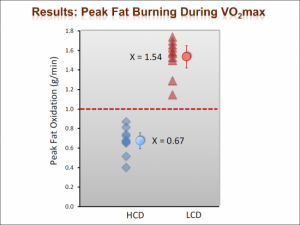
Both groups ran on a treadmill for 3 hours at 65% of their VO2 max for 3 hours while researches measured their respiratory quotient to determine how much carbs and fat they were burning.
Here is a comparison of the two groups and how much fat and carbohydrates they burned as a function of time duration of the 3 hour test. Notice the lower carbohydrate burning and drastically increased fat burning of the low carb group.
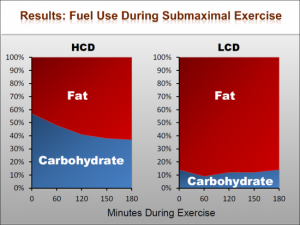
In theory this would provide a strong glycogen sparing effect during an endurance event.
Dr. Peter Attia has also done extraordinary work in this realm. Although his self experimentation doesn’t “prove” anything, it does help formulate hypotheses and provide a basis for understanding how his body works. Check out his blog here.
My Own Experiment in Fat Adapted Running
I first started experimenting with carb reduction while endurance training after reading Beyond Training, by Ben Greenfield. I’ve always struggled during longer endurance events in getting my nutrition “right”.
If I use the carbohydrate gels and sports drinks as directed, I seem to get diarrhea or have energy crashes. But if I don’t take in any calories during the race, I bonk.
I have had success using the low carbohydrate approach for physique transformation, but had never given it an honest try when pushing the endurance envelope. I figured I would run out of glycogen and bonk too easily.
But through research I learned how the body adapts to carbohydrate restriction by increasing the amount of GLUT-4 in the muscle cells. This pulls glucose from the blood into the muscles where it can be easily stored as glycogen.
So in a low carbohydrate state, you can actually more effectively carbohydrate load to increase your glycogen stores.
I reasoned that I could go low-carbohydrate most of the time and occasionally refill my glycogen stores. For me, low carbohydrates means about 75 to 100 grams per day. I would be relying on stored fat during my endurance efforts.
This would allow me to get by on less sugar and carb intake during an event.
So far I have found a large improvement in performance in endurances races while reducing my during-race caloric intake. In May, I had a personal best in a 6-hour trail race, Marwalkee’s Beast for a Day.
A few weeks later I had a personal best in the Crossfit workout nicknamed “Murph”. I completed it in under 50 minutes wearing a 20 pound vest, 17 minutes faster than two weeks prior. I did this with just a little bit of carb loading (150 grams) on the previous day.
How to Get Fat Adapted
The best approach I have found for getting to a fat adapted state is Ben Greenfield’s Superhuman Food Pyramid. It is what I have used to become fat adapted.
This approach emphasizes healthy fats and non-starchy vegetables and doesn’t have you eliminating food groups entirely. In addition to keeping tabs on number of grams of carbohydrates, it has worked great for me.
Tips for Getting Fat Adapted
1. Reduce carbohydrates gradually.
If you’ve been eating most of your calories as carbohydrates, your body is very reliant on carbohydrates for energy. If you drastically reduce your carbohydrate intake, you will probably feel terrible for a few days.
If you’re willing to feel crappy for a few days, then go ahead and cut your carbohydrate intake to less than 100 grams per day. If not, then reduce your carbohydrate intake to less than 200 grams on your first week.
Then, reduce it to less than 150 grams/day the following week and 100 grams/day the week after. By the fourth week you will be cruising at less than 100 grams of carbohydrates per day.
The fat-adapted athletes in the FASTER study were on 10 to 12 percent of calories from carbohydrates. For someone eating 3000 calories a day, that’s 75 to 90 grams of carbs per day.
This gradual approach should make the transition easier. A less gradual approach will be faster but more difficult.
2. Lower your expectations initially.
As you decrease carbohydrates, your performance will go down initially. You may not want to make this transition when you are very close to an upcoming race or event.
Give yourself a few months to adapt.
3. Experiment with fasted exercise.
In addition to carbohydrate reduction, exercising in a fasted state can be a way to shift your body’s metabolic engines to fat burning mode. Try a low intensity walk/run workout in the morning before eating.
If you feel like you need carbs before or during a workout, it’s a sure sign that your body is not efficiently burning fat at its highest potential.
Remember that your performance will probably suffer at first. But eventually your body will become efficient at tapping into the 35,000+ Calorie storehouse of energy it’s carrying in fat cells.
4. Carb load strategically.
There is a certain exercise intensity where fat cannot be burned. Anything that is anaerobic, or an intensity that surpasses your body’s ability to provide oxygen to the working muscles, will require carbohydrates.
This is why it’s good to carb load before a race or especially intense workout, even when you’re fat adapted. (Remember the fuel tank analogy.) Your want to have some of the high power fuel on board, you just don’t want to use it at your cruising speed.
5. Moderate your protein intake.
A big mistake in low carbohydrate eating plans is too much protein. The energy you remove by carb reduction has to be replaced with either fat or protein. Proteins can be used for energy, but the process is inefficient and produces lots of waste products.
Fats are a better option. The fat adapted athletes in the FASTER study were consuming 70% of their calories from fat. This is the only viable way for any endurance athlete to reduce carbohydrates.
Relying on protein as an energy source is too inefficient metabolically and produces too much waste. This requires water for the kidneys to filter the waste, leading to increased urination and dehydration.
6. Get over your fat phobia.
As a child of the 80s and 90s, I grew up inundated with anti-fat messages.
But with experimentation and further research I found that fear of eating a high fat diet is unfounded. In the context of low carbohydrate intake, saturated fat is not a problem.
Don’t misunderstand me. It is not healthy to add fat to the Standard American Diet. That will result in increased health risks.
But in the context of low carbohydrate intake, most studies have found that any cholesterol increase is offset by an improvement in triglycerides and LDL:HDL ratios as well as small particle count improvements.
A Note About Ketosis
Low-carbohydrate diets can sometimes induce a state of nutritional ketosis. When your body is burning fat rapidly, it does so by breaking down long chain fatty acids into smaller molecules of ketones.
Some low-carbohydrate eaters will make ketosis the goal. This is a good way to ensure that the body is burning a large amount of fat, but may not be necessary in order to become fat adapted.
Some traditional dieticians and medical professionals warn against the dangers of ketosis and cite some of the pitfalls of diabetic ketoacidosis as the reasons for avoiding ketosis. Nutritional ketosis is not the same as ketoacidosis
Diabetic ketoacidosis is a medical emergency. Nutritional ketosis is a state that arises from eating very low carbohydrates or fasting. It is a benign metabolic state and may even have health benefits.
Sources:
High Fat Diets and Endurance Exercise Performance
What Does it Mean to Be Fat Adapted?
Why Low-Carb Diets are Terrible for Athletes: Part 2
The Importance of Carbohydrates and Glycogen for Athletes
The Emerging Science of Fat Adaptation
Takeaways From the FASTER Study
Pt. 1 – Dr. Jeff Volek and Zach Bitter: Introducing the FASTER Study and Low-Carb Fueling for Athletes
Beyond Training, Ben Greenfield
References:
1. Training with low muscle glycogen enhances fat metabolism in well-trained cyclists
Author:
Nick Ortego is a health coach specializing in biohacking for runners. He integrates modern methods with the ancient wisdom of yoga to help runners get the most out of every aspect of life. He is the owner of N 2 Action, a wellness studio in Baton Rouge, Louisiana, offering personal training, health coaching, yoga, and fascial stretch therapy.
